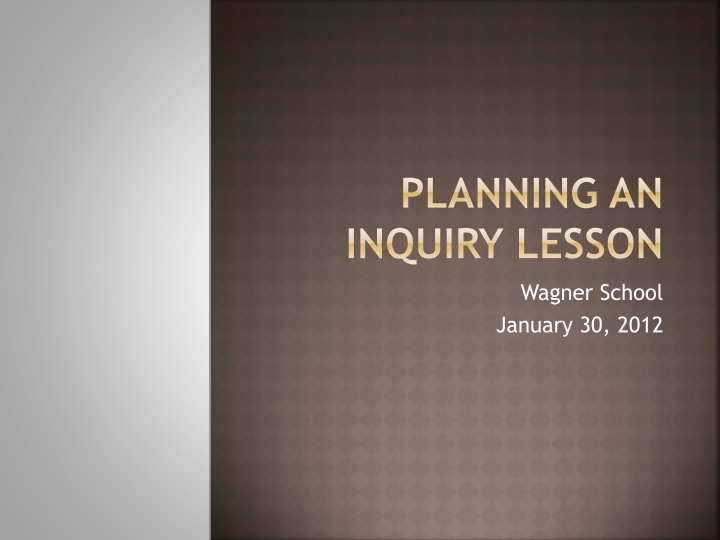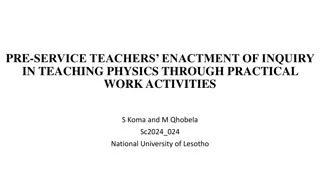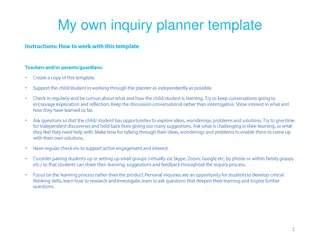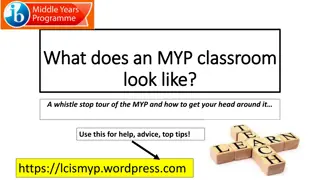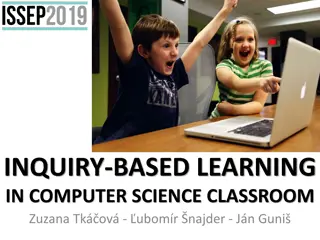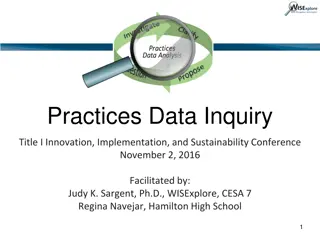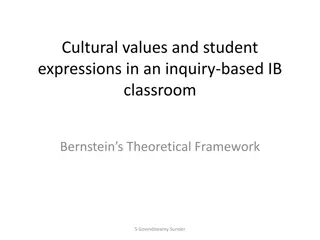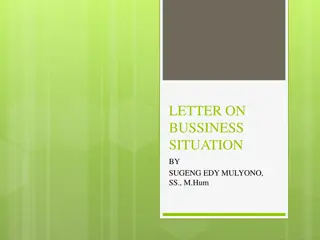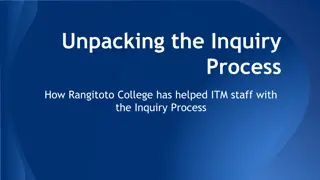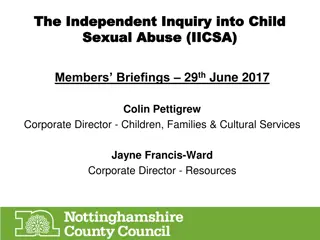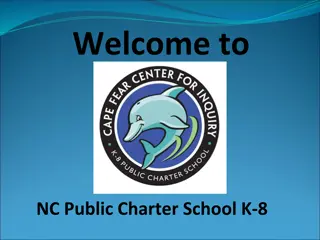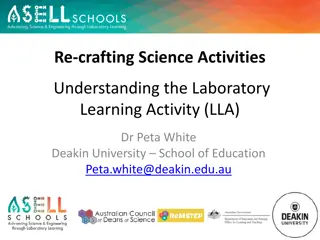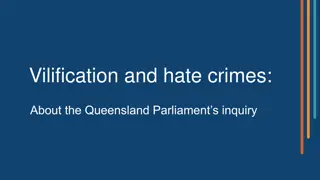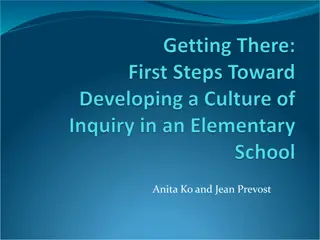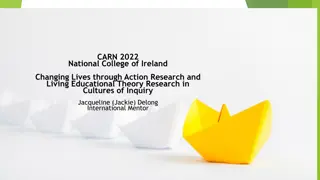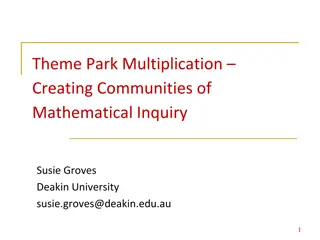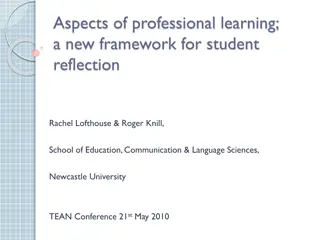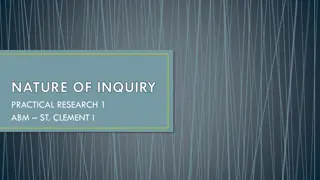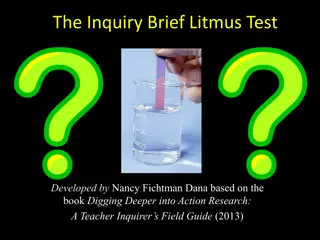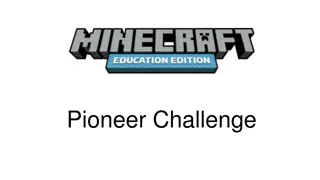Empowering Inquiry Learning
Embrace collaborative inquiry to foster deep engagement and knowledge construction among students. Shift from certainty to curiosity, from isolation to community, and from passivity to active research. Explore the transformative power of inquiry-based learning in education.
Download Presentation

Please find below an Image/Link to download the presentation.
The content on the website is provided AS IS for your information and personal use only. It may not be sold, licensed, or shared on other websites without obtaining consent from the author.If you encounter any issues during the download, it is possible that the publisher has removed the file from their server.
You are allowed to download the files provided on this website for personal or commercial use, subject to the condition that they are used lawfully. All files are the property of their respective owners.
The content on the website is provided AS IS for your information and personal use only. It may not be sold, licensed, or shared on other websites without obtaining consent from the author.
E N D
Presentation Transcript
PLANNING AN INQUIRY LESSON Wagner School January 30, 2012
ACTIVATION In your grade level group, discuss: What is inquiry? What are our fears about inquiry?
INQUIRY is approaching learning deeply, from the inside out. Schellert, Datoo, Ediger and Panas, 2009
http://infolit.org/archives/4694/why- information-literacy/
OUR DAY Establishing a collaborative space Philosophy of inquiry Curiosity and the Fundamental Flip Compelling questions Planning an inquiry lesson Role of unpacked outcomes and assessment Engaging students in the process Developing a tool box
COLLABORATIVE INQUIRY Learning occurs when we shift from professional certainty to conscious curiosity, from isolated individual to collaborative community member, and from passive technician to active researcher. The pursuit of meaningful questions arises from thoughtful data analysis, careful problem framing, and ongoing monitoring of gaps between goal achievement and current condition.
INQUIRY is based on the belief that understanding is constructed in the process of people working and conversing together as they pose and solve the problems, make discoveries and rigorously test the discoveries that arise in the course of shared activity. Galileo.org website
INQUIRY CYCLE Reflection and action are linked as ongoing elements of the inquiry process.
STUDENTS WHO ARE ENGAGED IN INQUIRY Construct deep knowledge and deep understanding rather than passively receiving information. Are actively involved and engaged in the discovery of new knowledge. Encounter alternate perspectives and different ideas. Transfer prior knowledge into deep understandings through new learning experiences. Take ownership for their own learning. Are resilient because they come to understand that learning takes time and perseverance. Practice creativity, problem-solving, collaboration and efficacy.
WHAT DO WE WANT? It boils down to the quality of learning we desire for those we are charged to educate. Do we want them simply to memorize facts and procedures in order to pass a test? Or do we want them to want to know, to seek to know, and ultimately, to understand themselves and their world more deeply as a result of their knowing? Diane Parker, 2007
CURIOSITY AND THE FUNDAMENTAL FLIP
INQUIRY you wonder about something and you want to know it in fact you re driven to know it because it s intriguing, puzzling, fascinating, and/or personally meaningful to you. Diane Parker, 2007
Moving from answering to asking Moving from solving to seeking Moving from definitive to open-ended
INQUIRY SPACE In a genuine inquiry, the topic itself matters far less than the attitude kids and teachers take toward it. If they are moved to ask why, to wonder who thinks otherwise, to explore what other strange things just might be connected to this one little problem, then they are in an inquiry space. Clifford & Marinucci, 2008
CLARIFICATION Inquiry relies on problems that are of emerging relevance to students. However, relevance does not have to be pre-existing for students. Relevance can emerge through teacher mediation.
WE MAY HAVE TO HOOK STUDENTS INTO WONDERING
BRAINSTORMING ACTIVITY What kinds of learning excites students? How do you know when they are excited? What kinds of learning excites you?
Consider authentic and engaging audiences and purposes!
ENTRY INTO INQUIRY Develop a culture of wonder in your classroom. Encourage students to ask questions which lead to more questions. Write the questions down. Create situations in which wonder and questions can grow. Provide access to multiple resources. Design classroom areas for stimulation, contemplation and idea generation.
MORE IDEAS Use a variety of texts to cultivate curiosity. Connect to personal artifacts and experiences. Take students beyond their four walls. Offer language frames such as I wonder , I think , This is what I see , This is what it tells me Encourage personal responses and personal connections. Consider before, during and after strategies in every subject. Play, invite exploration, experiment, simulate and laugh.
INQUIRY-ORIENTED INSTRUCTION MODELS Project-based learning Problem-based learning Group investigations Inquiry groups Guided inquiry Experiments Inquiry circles Simulations Experiential learning
Unpacking the Outcome Explain importance Outcome (circle the verb and underline the qualifiers) RW 5.1 Explain the importance of sustainable management of the environment to Canada s future. KNOW Examples of renewable resources forests, fish, water Examples of non-renewable resources oil, minerals Examples of non-sustainable practices presence of plastics, packaging, dumping of waste into river systems Examples of consequences for non-sustainable practices lack of resources for future generations, endangered species, climate change Resources forests, tar sands, coal, uranium, potash Examples of sustainable policies and actions water conservation, informed decisions by consumers, reusing materials Vocabulary renewable, non-renewable, resource, sustainable, non-sustainable, extraction, environment, policy, action ESSENTIAL QUESTIONS How are renewable and non-renewable resources different and how does this difference impact their sustainability? Why do humans engage in non-sustainable practices? How can I live in a more sustainable way? How is the environment impacted by both extraction and use of resources? How do policies and actions impact resources and the environment? How can I make a difference? UNDERSTAND That there is a difference between renewable and non-renewable resources and this difference impacts the sustainability of these resources There are a number of non- sustainable practices that humans engage in That if we adopt sustainable practices, there will be economic consequences (which is why this is a controversial topic) That both the extraction and use of a resource impacts the environment That there are policies and actions than can contribute to sustainability Everyone can make a difference! BE ABLE TO DO Differentiate between renewable resources and non-renewable resources Create an inventory of current non- sustainable practices List the possible consequences of non-sustainable practices related to the use of resources Taking one resource as an example, illustrate how resource use and the extraction process of a resource affects the environment Give examples of policies and actions that contribute to sustainability
Exceeding expectations Meeting expectations independently Mostly meeting expectations with assistance Not yet meeting expectations, even with assistance You are having trouble explaining the importance of sustainable management of the environment to Canada s future. Why is the environment so important to Canada? What do we mean by sustainable management? Explain the importance of sustainable management of the environment to Canada s future You show a deep understanding of the importance of sustainable management of the environment to Canada s future. You can not only clarify the difference between renewable and non-renewable resources and sustainable and non- sustainable practices but you can offer suggestions as to how various groups within Canada can increase their sustainable practices. On your own, you can explain the importance of sustainable management of the environment to Canada s future. Your explanation includes a clarification of the difference between renewable and non-renewable resources and sustainable and non-sustainable practices. With some help, you can mostly explain the importance of sustainable management of the environment to Canada s future. Ensure you can explain renewable and non-renewable resources and sustainable and non-sustainable practices on your own. Renewable Non-renewable Sustainable Non-sustainable Management of environment Impact of environment on Canada
REMEMBER Other outcomes will likely become involved (normal) but you are deciding which outcome you are specifically building toward and will eventually summatively assess.
CHOOSING A TOPIC FOR THE LESSON Look at your Dos and choose a topic suitable for an inquiry lesson Cross-reference with the rubric Identify which part of the rubric this lesson will address (formative)
ROLE OF THE ASSESSMENT EVENT IN THE LESSON PLAN
How will this look in the end? Important to clarify to students and self why the understandings generated in the inquiry are important. Helps to determine what to do with the gathered information (collect, save, synthesize, etc.)
USING RUBRICS AS PART OF THE LEARNING PROCESS
KINDS OF FORMATIVE ASSESSMENT IT S ALL ABOUT TIMING!! Formative (Exit card) Formative (StudentsAchieve) 8 Day Example (The final formative) Helps to clarify studying and extra learning needs prior to the summative event Can be entered into SA Invites differentiation Gives information for Professional Judgement Can support constructive conversation
It all starts here for students!! COMPELLING QUESTIONS
FIND A PLACE TO POST COMPELLING QUESTIONS Questions have value!
COMPELLING INQUIRY QUESTIONS Well-formulated inquiry questions are broad in scope and rich in possibilities. Such questions encourage students to explore, observe, gather information, plan, analyze, interpret, synthesize, problem solve, apply critical and creative thinking, take risks, create, conclude, document, reflect on learning, and develop new questions for further inquiry.
COMPELLING QUESTIONS What does it mean to be normal? Why can t we just get along? (global relations) What is childhood? What are we eating and what does it mean for our planet? Why do we do things that are bad for us, even when we know better? How does being heroic mean different things for different people? Why should I care about other people s stories? What does it mean to misbehave? Who decides?
REMEMBER Students have to learn that their opinions and knowledge are important. Learning is not about right or wrong. Students have been trained to only give knowledge when it reflects what the teachers know. Constructing knowledge is a risk for students. Students will sometimes show impatience with the thinking process when they perceive it as an impediment to getting the work done.
We are an answer- oriented society This is challenging for students We have to teach children to be curious again
NON-SUSTAINABLE PRACTICES Why is it so hard for people to take care of the environment? How do we NOT care for our world?
DIGGING DEEPER Non-sustainable practices are based on conflicting needs
CREATING COMPELLING QUESTIONS As a team, generate questions that get at the heart of your chosen topic. Don`t worry about filtering this is a general brainstorm (it usually takes time to get to the compelling layer of questions). Record your questions on Google Docs. We will look at all questions and choose the most compelling together!
Guiding inquiry planning THE GRAPHIC
INQUIRY is determined by a combination of what students want to know and what will meet the expectations of the audience for their inquiry. Rycik & Irvin, 2005
Great work! This is going extra well for you! You did it and you did it on your own! Good start. You are beginning to make sense of this on your own. You can do it. Spend some extra time with the criteria and ask for help. You have clearly engaged in the topic of interest and have formulated a number of insightful questions that have led to an in depth inquiry process that is highly engaging for your purpose and your audience. You insightfully and fully summarized your growth in personal knowledge and understanding from the beginning of your inquiry through to the end. You were able to discuss how your gain in knowledge fuelled your inquiry and answered question you had about your topic. Impressive! You have a great ability to assess the knowledge you have learned and to synthesize the information to make an informed, insightful conclusion. You have understood your topic and have asked appropriate questions to lead to a solid inquiry that is appropriate for your audience and purpose. Some help was needed to explore the topic and formulate questions which would lead to inquiry. More time could be spent exploring how a topic is interesting and who you are trying to speak to. Much help was needed to you through the inquiry process. More time must be spent asking questions before beginning to find out answers. What do you want to know about your topic? Formulate questions At the beginning of your inquiry journey, you were able to summarize your prior knowledge and understanding. After your exploration was complete, you were able to explain the growth in your personal knowledge and understanding You are able to assess the knowledge you have gained through the inquiry process and form some strong conclusions. With help, you were able to summarize some of the growth in knowledge and understanding you had from the start to the end of your inquiry. Look back in your work and consider where you started. How did you come to fully answer your questions? How can your share this clearly and on your own? You need some help assessing the knowledge gained through the inquiry process. You are unclear of how the knowledge gained answers your original question. Think about how the information you have learned helps you answer your original question. Think about what you started out knowing about your topic. Think about what you learned. How can you share this increase in knowledge and understanding so others can see your path to learning? Summarize personal knowledge and understanding Message/Meaning Think about exactly how the information that you have learned answers your original question. Did the information answer your question clearly? Do you need to dig deeper to answer your question more fully? Were you sidetracked in your research and did you gain knowledge that wasn t directly to your question? Assess knowledge gained and form personal conclusions
Date: Topic: Hook: What activities, artifacts, images, invitations, and experiences are you going to use to hook interest and set the stage for the inquiry? How will you begin to teach students to be curious about this topic? Compelling question(s): What question(s) will you start with to engage students and to set a strong purpose for their inquiry? What questions will you ask to prompt even more questions? Knowledge and Vocabulary: What knowledge and vocabulary will you use to add focus, clarity and understanding? How does this knowledge and vocabulary connect to the outcome? Groupings and process: Tool box: What are your parameters for groupings? Pairs? Individual? Make sure you have backfilled with the necessary skills to be able to work in the groupings you decide on. What processes will you allow? How will you activate prior knowledge? What are the tools you will invite students to use? What skills have you spent time building? Is this their first exploration or are they seasoned inquirers? Further questions generated: Information gathering process: What questions emerged from the inquiry process? How did students move more deeply into the topic? Where can students record their questions? Where and how will students record their new understandings? Where is data stored? How have you made students aware of the importance of this information? How will it lead to future inquiry? Why is it important? Readiness needs (backfilling): What are the prerequisite skills students must have before engaging in this inquiry? What tools and groupings will require some skill development? Make sure students are ready to engage in inquiry. When and how will you work on those skills? Lesson-end assessment: How will you know if each and every student has learned something? How will you measure progress toward your criteria?
NOTICE ...NO LESSON SEQUENCE Hook and compelling questions Explore and assess Regroup and Re-question Explore and assess Regroup and re-question Explore Assess
FIVE WHYS... What else do we need to know? How can we continue to explore this complex question? Why? Why? Why? Why? Why?
HABITS OF EXPERTS Ask good questions Break problems into parts Look for patterns Rely on evidence Consider other perspectives Follow hunches Use familiar ideas in new ways Collaborate with others Welcome critique Revise repeatedly Persist Seek new challenges Know yourself
With inquiry, students know what learning looks like!
INQUIRY ENVIRONMENT Sometimes considering how you will organize your classroom (learning space) will facilitate inquiry. Move the focus away from teacher-centered, to flexible learning areas. http://vimeo.com/7450433
Stewart Hawke LET THE STUDENTS TELL YOU
